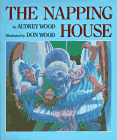In a Cabin in a Wood

by Darcie McNally. Illustrated by Robin Michal Koontz. ![]() Picture Book. 32 pages. Grades PreK-2.
Picture Book. 32 pages. Grades PreK-2.
Find this book: Amazon

Teacher's Guide
An old folk song is the basis for this book:
In a cabin in a wood,The book starts there, but the text and the illustrations tell a story quite different from the one you probably had. First of all, the "little old man" is an artist, painting what he sees from the window of his cabin. What he sees is a photographer "shooting" a rabbit. The unwilling model rabbit begs to be and is admitted to the cabin. However, all this is observed by a mother possum and her babies who know a good thing when they see it. They're the next knockers at the door wanting in because the raccoon who is lurking outside will pull their tails. Next comes the raccoon, then a beaver, and finally, a moose.
A little old man by the window stood
Saw a rabbit hopping by, knocking at his door.
"Help me! Help me, Sir!" he said,
"Or the hunters will shoot me dead!"
"Come Little Rabbit, come inside.
Safely you'll abide."
All those animals in the house create the expected havoc, especially the baby possums, but the rabbit is a creative soul and he fetches black paint and brush for the artist who paints the rabbit to look like a skunk. When he knocks at the door, the others leave in a hurry, all except for one baby possum, and the final scene has the old man in the rocking chair holding the rabbit serenely, surrounded by the mess created by his visitors.
(Continued Below)
Advertisement:

Things to Talk About and Notice
- Work with the words and notice the change of words to less and less violent actions: the hunter will shoot the rabbit; the raccoon will pull the possum's tail; the beaver will thump the raccoon's leg; the moose will grab the beaver's fur; who will whack the moose's hide? What other kinds of hunters are there?
- Focusing on the illustrations, help the children predict the next visitor by looking at the pictures. Notice that one possum doesn't leave and is seen in each picture. Look at the damage as the story progresses. Deal with cause and effect by figuring out who or what did it. What about the initials left behind? What could they possibly stand for? There are several possibilities. Watch the upstairs window.
- The solution to the problem is found by the rabbit. What if one of the other animals came up with the solution? How could they be disguised as an animal that will frighten the others? a porcupine? a tiger? a hunter?

Activities
- Sing the song. (The music and actions are on the last page.) Do it with motions. Let the children see the words in poster format. Sing it again.
- Look at the verbs in the story: hop, shoot, waddle, wail, prance, thump, dash, purr, grab, thud, whack. Change them. Mix them. Change the cast of characters. What if they were all bugs? reptiles? Change the scene. Figure out where this story must be taking place because of the cast of characters and then change it. What if it's a jungle house? an Eskimo house? your own house? What animals would be likely visitors there? What's in your refrigerator right now that you could feed such visitors?
- Act out the story using stuffed animals. Do it as a puppet opera -- no talking aloud, only singing. Make rebuses of the song. Do it as a shadow play.
(Continued Below)
Advertisement:

Related Books
- Compare this book to others. Make a chart showing likenesses and differences between these books and others with some similarities.

- Dealing with overcrowded houses, there are several variations of the folktale in which a man complains that his house is too crowded and the wise person recommends making it more crowded in order to appreciate the space now. "No Room" is one of the titles that tale goes by.
- Cynthia Rylant's The Relatives Came (Bradbury, 1985 ISBN 0-02-777220-9) also deals with an overcrowded house but everybody's having such a good time, nobody cares that there really isn't enough room.
- Cabin in the Woods also has elements in common with Don and Audrey Wood's The Napping House (Harcourt, 1984 ISBN 0-15-256708-9) and Jan Brett's The Mitten (Putnam, 1990 ISBN 0-399-21920-X)
- Dr. Seuss's Thidwick the Big-Hearted Moose (Random, 1962 ISBN 0-394-90086-3) is another book where too many animals are crowded into a small space -- Thidwick's antlers.
(Continued Below)
Advertisement:

Related Areas Within Carol Hurst's Children's Literature Web Site
- Math Out Loud: Math and the Oral Traditions
- Free Teacher's Guides: A listing of all our teacher's guides. Picture Books, Nonfiction and Fiction.

